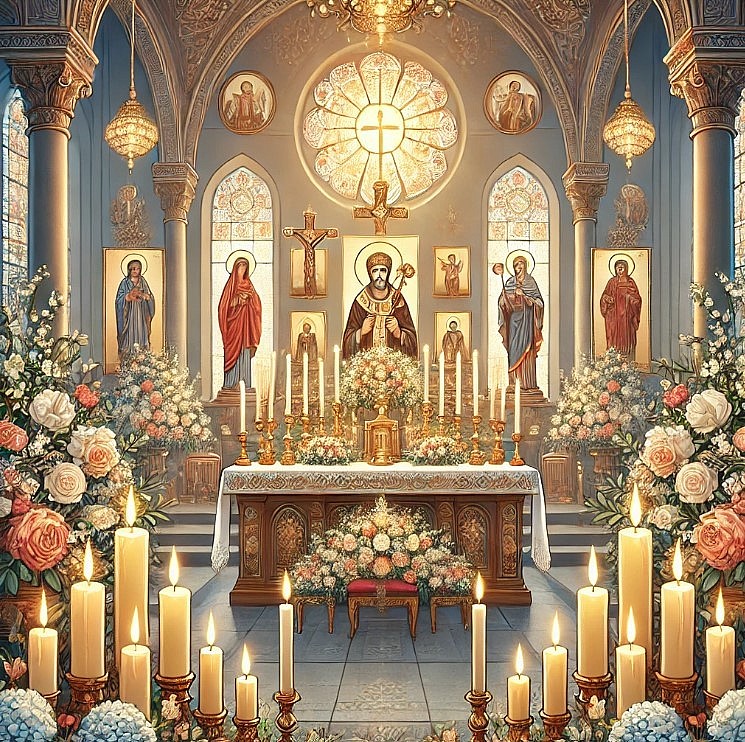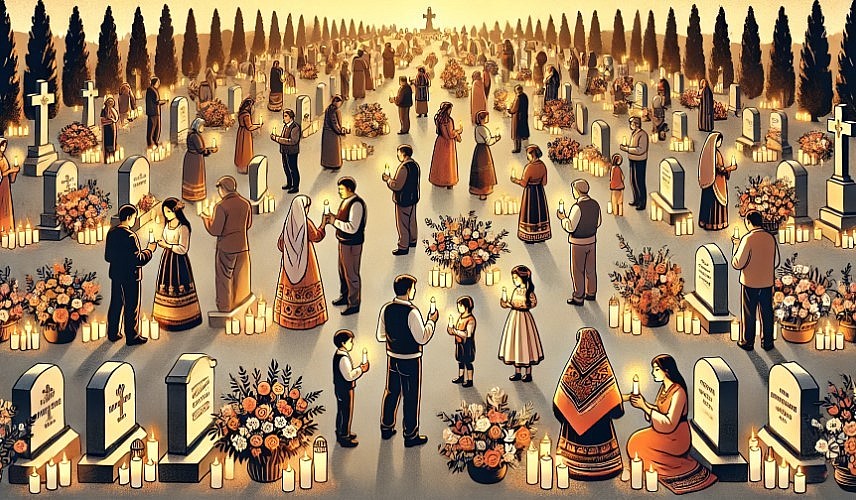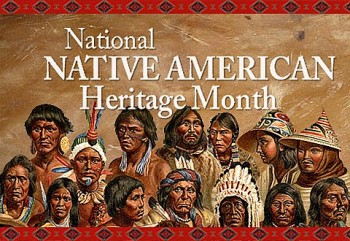All Saints' Day - Origin, Meaning, Traditions, and Celebrations Around the World
Known as All Hallows’ Day or Feast of All Saints, it honors all saints and martyrs of the faith, both known and unknown, who led exemplary lives and contributed significantly to Christianity. The day is an occasion to remember those who have entered the Kingdom of Heaven, and it serves as an inspiring reminder of the virtues and sacrifices that define sainthood.
Observed by Catholics, many Protestants, and the Orthodox, All Saints’ Day has roots in early Christian history and holds special significance for communities globally. Through customs, prayers, and family gatherings, people around the world celebrate in ways both solemn and celebratory. This article delves into the origins, evolving meaning, and various traditions that mark All Saints’ Day across cultures. From its spiritual purpose to its vibrant local customs, All Saints’ Day continues to be a cherished time for reflection and community, linking people to a shared past and universal values.
Learn more: All Souls' Day - Origins, Significance, Lessons, And Traditions Around The World
 |
| All Saints' Day customs from around the globe |
Origins and Historical Background
All Saints' Day traces its origins to the early days of Christianity. The first recorded instance of honoring martyrs collectively appears in the 4th century. Early Christian communities, often under persecution, revered those who died for their faith, and the need arose to remember them in a collective, solemn observance. Initially celebrated sporadically in different regions, the day became more formalized over time.
-
The Institution of All Saints’ Day: The celebration as we know it began to take shape in the 8th century when Pope Gregory III dedicated a chapel in St. Peter’s Basilica to all saints and martyrs, officially designating November 1 as All Saints’ Day. Later, in the 9th century, Pope Gregory IV expanded its observance to the entire Church, cementing the day’s place in the Christian calendar.
-
Transition from Pagan to Christian Traditions: Interestingly, the establishment of All Saints' Day on November 1 aligns with the ancient Celtic festival of Samhain, which celebrated the end of the harvest season and the beginning of winter. This strategic overlap allowed for an easier transition from pagan rituals to Christian observances, as people were already accustomed to commemorating the dead around this time of year.
-
The Evolution of All Saints’ Day: Throughout the medieval period, the day grew in importance and began to embody the ideals of sainthood, serving as a reminder of both heaven’s promise and the moral path expected of the faithful. In England, it became known as All Hallows' Day, giving rise to “All Hallows’ Eve” or Halloween, the day preceding All Saints’ Day.
By the time of the Reformation, the day was observed widely across Europe, though Protestant reformers later modified or rejected certain aspects of its celebration. Nevertheless, All Saints' Day remains an enduring festival in both Catholic and Protestant traditions, offering a day to honor the virtuous lives of saints and call the faithful toward a life of devotion and service.
Interesting Fact: In the Eastern Orthodox Church, All Saints’ Day is celebrated on the first Sunday after Pentecost rather than on November 1, emphasizing the connection between the saints and the Pentecostal gifts of the Holy Spirit.
The Meaning of All Saints’ Day
All Saints’ Day holds a deep spiritual significance for Christians worldwide. It is a day set aside to honor the "communion of saints" — a community of both known and unknown individuals who, through faith and sacrifice, dedicated their lives to the teachings and service of Christ. Unlike most feasts that commemorate specific saints, All Saints' Day celebrates the entire body of saints collectively, including those who may not have been canonized formally by the Church but are nonetheless considered worthy of reverence.
-
Symbolism and Purpose: The primary purpose of All Saints' Day is to celebrate holiness and remind the faithful of their spiritual calling. It is a reminder that sainthood is achievable by any individual, as long as they strive to live in alignment with the virtues of faith, love, and compassion. This day encourages people to reflect on the lives of the saints as models of Christian virtue, inspiring them to live similarly dedicated lives.
-
Catholic and Protestant Perspectives: Within Catholicism, All Saints' Day has a prominent place as a Holy Day of Obligation, where attending Mass and participating in prayers are considered essential practices. Many Catholic services focus on recounting the lives of the saints, especially those canonized, as well as prayers to inspire believers to emulate their virtues. In contrast, Protestant observances vary, with some denominations embracing the day as an opportunity to honor all Christians who have passed, while others may view it as a day to reflect on the broader Christian community without specific prayers to saints.
-
Spiritual Significance: All Saints’ Day serves as a reminder of the unity of the Church — past, present, and future — and symbolizes the connection between the earthly realm and the heavenly one. The day embodies the hope and promise of eternal life and serves as a reminder to believers that, through their own faith and actions, they too can one day join this divine community.
While saints are often perceived as exceptional figures, All Saints’ Day emphasizes that holiness is attainable for all. It calls believers to examine their lives and consider how they can act in ways that reflect their values, encouraging each person to make positive changes, no matter how small, in their everyday lives. This day provides a collective moment to celebrate human potential for goodness and the belief in the interconnectedness of all believers in the journey toward a higher calling.
Traditions and Customs Around the World
 |
| The illustration of a church altar prepared for All Saints' Day, featuring candles, flowers, and saints' icons. |
All Saints' Day is celebrated in various ways across different countries and cultures, each bringing unique customs and traditions that reflect both local identity and shared Christian values. Here’s a look at how the day is observed in different parts of the world:
-
Europe:
- Spain: In Spain, All Saints’ Day is a significant holiday. Families visit cemeteries to clean and decorate the graves of loved ones, offering vibrant floral tributes, usually with chrysanthemums, which symbolize eternity. Traditional foods, such as huesos de santo (saint’s bones) and buñuelos de viento (fried dough balls), are enjoyed as people gather with family to remember the departed.
- France: Known as Toussaint, All Saints’ Day is a day for families to visit cemeteries and place flowers on the graves of loved ones, particularly chrysanthemums. French people regard it as a time for family togetherness and remembrance, with many taking time off to spend the day with relatives.
- Italy: Italians celebrate All Saints' Day with great reverence, often attending Mass in the morning and then visiting cemeteries to pray for departed souls. In some regions, the day extends into All Souls' Day, where families gather for meals and share stories to keep the memories of loved ones alive.
-
Latin America:
- Mexico: The Mexican tradition of Día de los Muertos (Day of the Dead), although distinct from All Saints' Day, overlaps and shares similar roots. This lively celebration begins on October 31 and extends through November 2, with November 1 specifically honoring children and infants, often called Día de los Inocentes. Families build altars with offerings (or ofrendas) including photographs, food, and personal mementos, blending indigenous and Christian practices in a colorful festival that celebrates life and memory.
- Peru: All Saints’ Day is marked with gatherings at cemeteries where families often hold picnics near the graves of their loved ones. Traditional foods, like tantawawa (a type of bread shaped like a baby), are enjoyed, and the day reflects a mix of Catholic and indigenous Andean influences.
-
Asia:
- Philippines: Known as Undas, All Saints’ Day is one of the most widely observed holidays in the Philippines. It’s a time for family reunions, as people travel to ancestral homes and visit cemeteries to clean and decorate graves, light candles, and offer prayers. Some families even camp out at cemeteries, staying overnight to keep the memory of their loved ones alive.
- India: In Goa and certain regions with Catholic communities, All Saints’ Day involves special Masses, with parishioners lighting candles and leaving flowers on graves. The day reflects a blend of traditional Catholic rituals and local customs, where communities come together to honor the saints and deceased family members.
-
Africa:
- Nigeria: In Nigeria, All Saints' Day is celebrated within Catholic communities, often marked by a combination of traditional Catholic services and local customs. Families visit graves, hold community meals, and pray together, sometimes including local music and dancing to celebrate the lives of the saints and loved ones.
- Ethiopia: Among Ethiopian Orthodox Christians, All Saints' Day is observed with a special church service. Though it does not have the same prominence as other major holidays, it remains a day of reflection, prayer, and honoring the virtuous.
-
North America:
- United States: Observed mainly by Catholic and Orthodox communities, All Saints' Day in the U.S. includes attending Mass, lighting candles, and visiting cemeteries. In some regions, children dress as saints and learn about the lives of these figures. Celebrations are often more low-key compared to other countries but remain an important day for many Christian families.
- Canada: In Canada, All Saints' Day is observed primarily in areas with a strong Catholic heritage, such as Quebec. While it is not a public holiday, those who celebrate it attend Mass and may visit gravesites, with an emphasis on praying for the departed and the larger community of saints.
Unique Tradition Spotlight: In Guatemala, families fly colorful kites in cemeteries on All Saints’ Day. Known as barriletes gigantes, these kites symbolize the connection between the earthly and spiritual realms and are believed to help guide spirits back to their loved ones.
From the quiet prayers offered in European churches to the lively processions in Latin America, the diverse traditions surrounding All Saints’ Day show the universal nature of remembrance. Each culture brings its distinct practices, yet all share a common purpose: to honor those who have gone before and to cherish the lessons they have left behind.
Celebrations Today: Modern Observances and Global Significance
 |
| The illustration depicting families from diverse cultures gathered at a cemetery for All Saints' Day, lighting candles and laying flowers to honor their loved ones |
In the contemporary world, All Saints’ Day continues to hold great importance for many people, though the way it is celebrated has evolved with societal changes and cultural shifts. The day remains a significant occasion within the Christian liturgical calendar, observed by millions, yet secularization, modernization, and global influences have reshaped some aspects of its celebration. Here’s a look at how All Saints’ Day is celebrated in today’s world and why it still matters.
-
Changes in Modern Times: With growing secularization in some regions, the observance of All Saints’ Day has become less public in certain parts of the world, particularly in Europe. While many people continue to attend Mass and visit cemeteries, the overall participation has declined, especially among younger generations. Despite this, the holiday persists as a cultural reminder of the past, with traditions being adapted to suit the pace of modern life.
-
Role of the Church: In Catholic and Orthodox traditions, All Saints’ Day remains a Holy Day of Obligation, meaning that adherents are encouraged or required to attend Mass. The Church uses this day to remind the faithful of the values embodied by the saints and to celebrate the spiritual unity of all believers. Many churches hold special services, including processions and prayers for the deceased, aiming to deepen the connection between the congregation and the broader communion of saints.
-
Virtual and Community-Based Celebrations: In recent years, particularly with the COVID-19 pandemic, many churches have adapted by offering virtual services, allowing people to attend Mass and participate in prayers from home. Online gatherings and community-based events have also become popular, where families can share stories, pray together, and even light virtual candles in honor of loved ones. These adaptations have allowed All Saints' Day to remain accessible and relevant even amid social distancing and travel restrictions.
-
Public Holidays and Local Variations: All Saints' Day is still a public holiday in many countries, including Spain, France, Italy, and parts of Latin America, where it is often combined with All Souls' Day. In these regions, the day is marked not just by religious observance but also by social gatherings and family reunions. For instance, in countries like Mexico and the Philippines, people often travel long distances to return to their hometowns, using the holiday as an opportunity to reconnect with family and honor their roots.
-
Personal Reflections and Family Traditions: In many parts of the world, families have maintained their own unique traditions for All Saints' Day. Some families gather at home to remember their ancestors, sharing stories, photographs, and family history. For those who may not attend formal church services, the day becomes an intimate family event — a time to honor past generations and to pass on family values and traditions to younger members.
All Saints' Day has adapted with the times, yet it remains a powerful occasion for reflection, gratitude, and remembrance. Even as modern life brings new challenges and changes, the core of All Saints’ Day — the honoring of virtuous lives and the unity of the faithful — continues to resonate with people across different backgrounds and cultures. In a world that is constantly changing, All Saints' Day serves as a stable point of connection to the past, a way to ground oneself in tradition while drawing inspiration for the future.
Difference Between All Saints’ Day and All Souls’ Day
All Saints’ Day, celebrated on November 1, is often closely associated with All Souls’ Day, which follows on November 2. Although the two days are linked in purpose and timing, they have distinct meanings and traditions that serve different aspects of remembrance within the Christian faith.
-
All Saints' Day (November 1): This day is dedicated to honoring all saints, particularly those who have been canonized or recognized as holy figures by the Church. It is a day to celebrate the virtues and sacrifices of saints who have led exemplary lives and serve as models of Christian faith. All Saints’ Day includes both known and unknown saints, embracing the broader communion of saints who have attained Heaven and are venerated for their lives of faith.
-
All Souls' Day (November 2): All Souls' Day, in contrast, focuses on the souls of all the faithful departed, especially those believed to be in Purgatory, awaiting purification before entering Heaven. It is a day for praying for the dead, helping them on their journey to Heaven according to Catholic teachings. The day is often marked by prayers, lighting candles, and visiting the graves of loved ones, with the intention of supporting the souls of the deceased through acts of devotion and remembrance.
-
Theological and Cultural Differences: Theologically, All Saints’ Day is about celebrating the achievements of saints and martyrs who have already reached Heaven, while All Souls' Day is a more somber occasion focusing on those who may still need assistance on their journey. This distinction is reflected in the different customs and rituals observed on each day. For example, on All Souls’ Day, it is common in many cultures to light candles and say special prayers at the graves of deceased family members, while All Saints’ Day is more focused on attending Mass and honoring the lives of saints in a more general sense.
-
Customs Specific to All Souls’ Day: In Mexico, the Day of the Dead celebrations continue on All Souls’ Day, with more focus on commemorating the departed with elaborate altars, offerings, and family gatherings. In Eastern Europe, it is common to visit cemeteries, clean and decorate graves, and hold candlelight vigils in memory of deceased relatives. Similar traditions are observed in Poland, Hungary, and other parts of Europe, where All Souls' Day holds a special place as a time for family remembrance.
Comparison Table:
Difference Between All Saints’ Day and All Souls’ Day
This difference in purpose highlights the dual nature of remembrance in Christianity: All Saints' Day as a celebration of the spiritual triumph of those who have reached Heaven, and All Souls’ Day as an act of compassion and solidarity with those who may still need prayers and assistance on their spiritual journey. Together, these two days create a powerful, meaningful period of reflection and remembrance for Christians, bridging the gap between earthly life and eternal hope.
Significance and Lessons from All Saints’ Day
All Saints’ Day is more than just a day of remembrance; it serves as an opportunity for spiritual reflection, personal growth, and the renewal of faith. This day invites believers to consider the moral and spiritual values exemplified by saints and to integrate these principles into their own lives. Here are some key lessons and significant aspects of All Saints' Day:
-
Values and Life Lessons: The saints honored on All Saints’ Day are celebrated not only for their holy lives but also for the virtues they embodied, such as compassion, courage, humility, and resilience. By reflecting on the lives of saints, individuals are reminded of the potential for goodness within themselves. Saints are often ordinary people who demonstrated extraordinary faith and sacrifice, and this realization can inspire anyone to strive for kindness, integrity, and service in their daily lives.
-
How It Inspires People Today: All Saints’ Day serves as a source of motivation and hope for many, showing that sainthood is not limited to perfection or greatness but is accessible to all who strive to live with purpose and goodness. Believers are encouraged to honor the memory of saints by committing to positive actions, whether through acts of charity, community service, or personal spiritual growth. For some, the lives of the saints offer comfort in times of struggle, reminding them that others have faced challenges with faith and grace.
-
Moral Reflections for All Ages: The lessons of All Saints’ Day are universal and can resonate across generations. For children, stories about saints introduce concepts of kindness, bravery, and generosity, instilling foundational values at an early age. For adults, the day provides an opportunity to reflect on personal purpose and the impact of their actions on others. Families can use the day to share stories of admired saints or discuss the values they hope to pass on to future generations, creating a sense of shared heritage and moral responsibility.
Reflection: In today’s fast-paced world, where success is often measured by material accomplishments, All Saints’ Day offers a refreshing reminder of inner fulfillment and purpose. It challenges people to consider what kind of legacy they wish to leave behind, emphasizing values like compassion, humility, and faith over wealth or status.
Ultimately, All Saints’ Day serves as a bridge between the human and the divine, encouraging individuals to strive for spiritual growth and to honor the memory of those who lived lives of dedication and love. The saints, through their example, illuminate a path toward a meaningful life, and by celebrating them, believers are inspired to bring light into their communities and beyond.
Conclusion
All Saints' Day continues to hold a timeless relevance, connecting communities across generations and cultures. Through its rituals, traditions, and shared values, the day serves as a powerful reminder of humanity’s spiritual journey, emphasizing faith, love, and remembrance. In honoring the saints, believers are inspired to look inward, to seek moral strength, and to act with compassion toward others.
In modern society, where divisions and distractions are common, All Saints' Day offers a moment to pause, reflect, and connect with something greater than oneself. It reinforces the ideals of unity, kindness, and dedication, encouraging people to lead lives of purpose. Whether through quiet prayers, family gatherings, or community events, the spirit of All Saints’ Day brings people together to celebrate the enduring qualities of faith and virtue.
As society continues to change, the values embodied by saints remain relevant and powerful, showing that holiness is not beyond reach, but a possibility within every heart willing to live with love and integrity. All Saints' Day remains a cherished occasion for connecting with the past, honoring tradition, and looking forward with hope and resolve.
Frequently Asked Questions (FAQ)
-
Why do people visit cemeteries on All Saints’ Day?
- Visiting cemeteries on All Saints' Day is a way to honor the deceased and maintain a connection with loved ones who have passed. It allows families to remember and celebrate the lives of those who have come before, while offering prayers for their peace.
-
How is All Saints’ Day different from Halloween?
- Although they fall on consecutive days, All Saints’ Day and Halloween are different in purpose and tradition. Halloween, derived from “All Hallows’ Eve,” was historically a night of preparation and warding off spirits. In contrast, All Saints’ Day is a solemn day focused on honoring the saints and seeking inspiration from their lives.
-
Is All Saints’ Day only celebrated by Catholics?
- While All Saints’ Day is a major celebration in Catholicism, many Protestant denominations also observe it, though the customs may differ. Some Anglican and Lutheran churches commemorate the day, reflecting on the saints and faithful who have passed on.
-
How do children participate in All Saints’ Day?
- In many Christian communities, children participate in All Saints' Day by learning about the lives of saints and sometimes dressing up as their favorite saints to honor their stories. This practice helps teach young believers about the values of kindness, bravery, and faith.
-
Why is All Saints’ Day important in modern times?
- All Saints' Day remains significant because it encourages reflection on personal values, connects individuals to the history of their faith, and celebrates ideals that are universally valued, such as compassion, service, and unity. It reminds people of the importance of living purposefully and making positive contributions to their communities.
-
What are some symbols associated with All Saints’ Day?
- Common symbols include candles, which represent hope and remembrance; flowers, symbolizing respect and honor for the dead; and images of saints, reminding people of the lives and sacrifices of holy figures. In various cultures, these symbols are displayed in churches, cemeteries, and homes to create an atmosphere of reverence and gratitude.
 US Federal Holiday Pay Guide in November 2024: What Employees Should Know US Federal Holiday Pay Guide in November 2024: What Employees Should Know This guide will provide an overview of what employees should know about public holiday pay in November, including rights, pay rates, and potential differences between ... |
 Native American Heritage Month: History, Significance, and Celebrations Native American Heritage Month: History, Significance, and Celebrations Native American Heritage Month is celebrated throughout the United States in November, recognizing the rich cultures, histories, and contributions of Native Americans. |
 UK Calendar in November 2024 : Full List of National Holidays, Special Days and International Events UK Calendar in November 2024 : Full List of National Holidays, Special Days and International Events Many different cultural practices, memorials, and holiday preparations take place in the United Kingdom throughout the month of November. In chronological order, the following are ... |



























